人口分析项目
开发环境
- anaconda
- 集成环境:集成好了数据分析和机器学习中所需要的全部环境
- 安装目录不可以有中文和特殊符号
- jupyter
- anaconda提供的一个基于浏览器的可视化开发工具
需求
- 导入文件,查看原始数据
- 将人口数据和各州简称数据进行合并
- 将合并的数据中重复的abbreviation列进行删除
- 查看存在缺失数据的列
- 找到有哪些state/region使得state的值为NaN,进行去重操作
- 为找到的这些state/region的state项补上正确的值,从而去除掉state这一列的所有NaN
- 合并各州面积数据areas
- 我们会发现area(sq.mi)这一列有缺失数据,找出是哪些行
- 去除含有缺失数据的行
- 找出2010年的全民人口数据
- 计算各州的人口密度
- 排序,并找出人口密度最高的州
import numpy as np
import pandas as pd
from pandas import DataFrame
导入文件,查看原始数据
abb = pd.read_csv('./data/state-abbrevs.csv') # state(州的全称)abbreviation(州的简称)
abb.head()
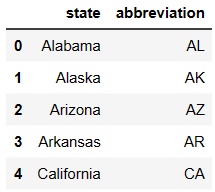
area = pd.read_csv('./data/state-areas.csv') # state州的全称,area (sq. mi)州的面积
area.head()
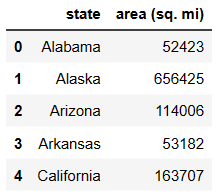
将人口数据和各州简称数据进行合并
pop = pd.read_csv('./data/state-population.csv')
# state/region简称,ages年龄,year时间,population人口数量
abb_pop = pd.merge(abb,pop,left_on='abbreviation',right_on='state/region',how='outer')
abb_pop.head()
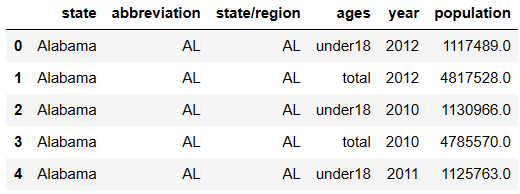
将合并的数据中重复的abbreviation列进行删除
abb_pop.drop(labels='abbreviation',axis=1,inplace=True)
abb_pop.head()
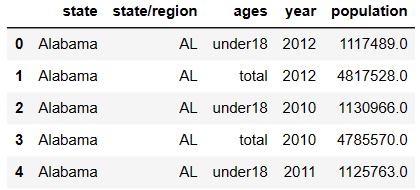
查看存在缺失数据的列
方式1
- isnull --> any
- notnull --> all
abb_pop.isnull().any(axis=0)
# state,population这两列中存在空值
state True
state/region False
ages False
year False
population True
dtype: bool
方式2
abb_pop.info()
<class 'pandas.core.frame.DataFrame'>
Int64Index: 2544 entries, 0 to 2543
Data columns (total 5 columns):
# Column Non-Null Count Dtype
--- ------ -------------- -----
0 state 2448 non-null object
1 state/region 2544 non-null object
2 ages 2544 non-null object
3 year 2544 non-null int64
4 population 2524 non-null float64
dtypes: float64(1), int64(1), object(3)
memory usage: 119.2+ KB
找到有哪些state/region使得state的值为NaN,进行去重操作(将state中的空值对应的简称找到,且对简称进行去重)
abb_pop.head()
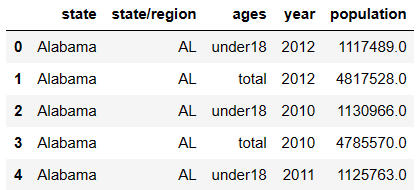
# 思路:可以将state这一列中的空值对应的行数据取出,从该行数据中就可以取出简称的值
# 1.将state中的空值定位到
abb_pop['state'].isnull()
# 2.将上述的布尔值作为源数据的行索引
abb_pop.loc[abb_pop['state'].isnull()] # 将state中空对应的行数据取出
# 3.将简称取出
abb_pop.loc[abb_pop['state'].isnull()]['state/region']
# 4.对简称去重
abb_pop.loc[abb_pop['state'].isnull()]['state/region'].unique()
array(['PR', 'USA'], dtype=object) # 结论:只有PR和USA对应的全称数据为空值
为找到的这些state/region的state项补上正确的值,从而去除掉state这一列的所有NaN
- 思考:填充该需求中的空值可不可以使用fillna?
- 不可以。
- fillna是使用空的紧邻值做填充
- fillna(value='xxx')使用指定的值填充空值
- 使用给元素赋值的方式进行填充
- 不可以。
1.先给USA的全称对应的空值进行批量赋值
1.1将USA对应的行数据找出(行数据中就存在state的空值)
abb_pop['state/region'] == 'USA'
abb_pop.loc[abb_pop['state/region'] == 'USA'] # 将usa对应的行数据取出
abb_pop.loc[abb_pop['state/region'] == 'USA'].head()
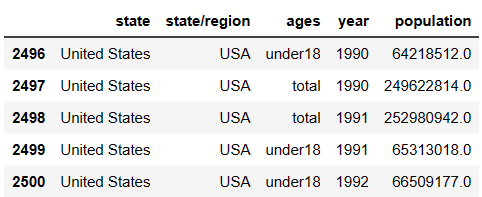
1.2将USA对应的全称空对应的行索引取出
indexs = abb_pop.loc[abb_pop['state/region'] == 'USA'].index
indexs
Int64Index([2496, 2497, 2498, 2499, 2500, 2501, 2502, 2503, 2504, 2505, 2506,
2507, 2508, 2509, 2510, 2511, 2512, 2513, 2514, 2515, 2516, 2517,
2518, 2519, 2520, 2521, 2522, 2523, 2524, 2525, 2526, 2527, 2528,
2529, 2530, 2531, 2532, 2533, 2534, 2535, 2536, 2537, 2538, 2539,
2540, 2541, 2542, 2543],
dtype='int64')
abb_pop.iloc[indexs]
abb_pop.loc[indexs,'state'] = 'United States'
abb_pop
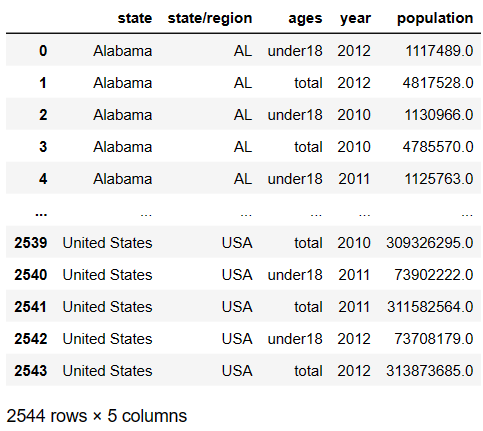
2.可以将PR的全称进行赋值
abb_pop['state/region'] == 'PR'
abb_pop.loc[abb_pop['state/region'] == 'PR'] # PR对应的行数据
indexs = abb_pop.loc[abb_pop['state/region'] == 'PR'].index
indexs
Int64Index([2448, 2449, 2450, 2451, 2452, 2453, 2454, 2455, 2456, 2457, 2458,
2459, 2460, 2461, 2462, 2463, 2464, 2465, 2466, 2467, 2468, 2469,
2470, 2471, 2472, 2473, 2474, 2475, 2476, 2477, 2478, 2479, 2480,
2481, 2482, 2483, 2484, 2485, 2486, 2487, 2488, 2489, 2490, 2491,
2492, 2493, 2494, 2495],
dtype='int64')
abb_pop.loc[indexs,'state'] = 'PPPRRR'
abb_pop
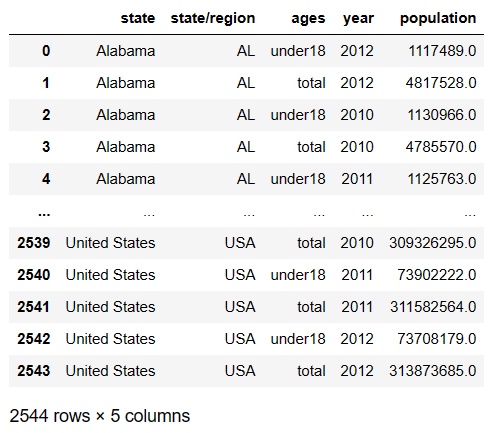
合并各州面积数据areas
abb_pop_area = pd.merge(abb_pop,area,how='outer')
abb_pop_area
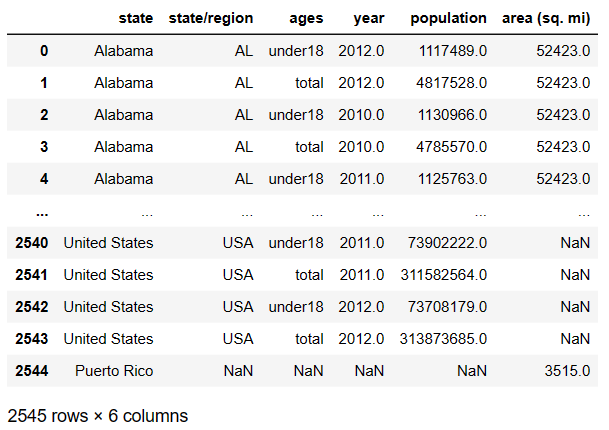
我们会发现area(sq.mi)这一列有缺失数据,找出是哪些行
abb_pop_area['area (sq. mi)'].isnull()
abb_pop_area.loc[abb_pop_area['area (sq. mi)'].isnull()] # 空对应的行数据
indexs = abb_pop_area.loc[abb_pop_area['area (sq. mi)'].isnull()].index
indexs
Int64Index([], dtype='int64')
去除含有缺失数据的行
abb_pop_area.drop(labels=indexs,axis=0,inplace=True)
abb_pop_area
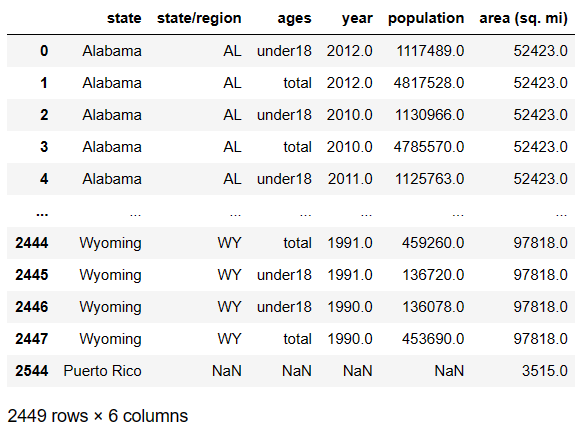
找出2010年的全民人口数据(基于df做条件查询)
abb_pop_area.query('ages == "total" & year == 2010')
abb_pop_area.query('ages == "total" & year == 2010').head()
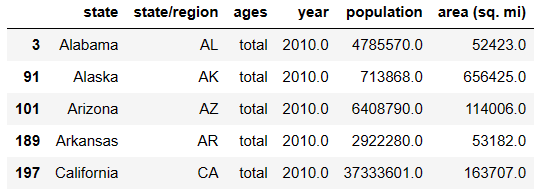
计算各州的人口密度(人口除以面积)
abb_pop_area['midu'] = abb_pop_area['population'] / abb_pop_area['area (sq. mi)']
abb_pop_area
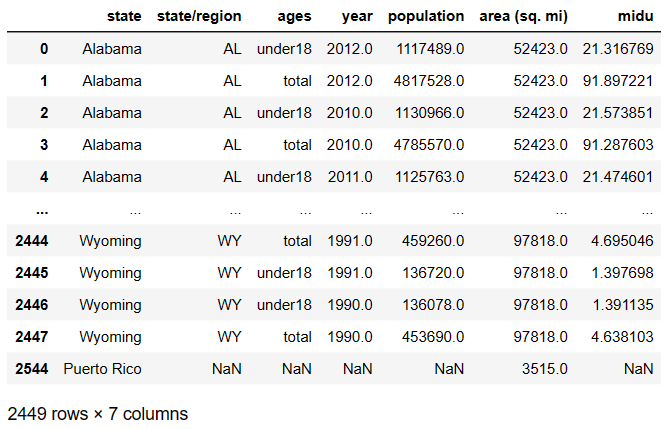
排序,并找出人口密度最高的州
# ascending=False 降序排序
abb_pop_area.sort_values(by='midu',axis=0,ascending=False).iloc[0]['state']
'District of Columbia'
本文作者:zylyehuo
本文链接:https://www.cnblogs.com/zylyehuo/p/17739197.html
版权声明:本作品采用知识共享署名-非商业性使用-禁止演绎 2.5 中国大陆许可协议进行许可。






【推荐】国内首个AI IDE,深度理解中文开发场景,立即下载体验Trae
【推荐】编程新体验,更懂你的AI,立即体验豆包MarsCode编程助手
【推荐】抖音旗下AI助手豆包,你的智能百科全书,全免费不限次数
【推荐】轻量又高性能的 SSH 工具 IShell:AI 加持,快人一步